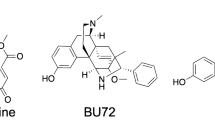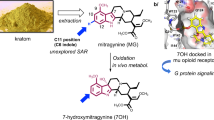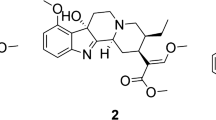Abstract
Management of chronic pain continues to represent an area of great unmet biomedical need. Although opioid analgesics are typically embraced as the mainstay of pharmaceutical interventions in this area, they suffer from substantial liabilities that include addiction and tolerance, as well as depression of breathing, nausea and chronic constipation. Because of their suboptimal therapeutic profile, the search for non-opioid analgesics to replace these well-established therapeutics is an important pursuit. Conolidine is a rare C5-nor stemmadenine natural product recently isolated from the stem bark of Tabernaemontana divaricata (a tropical flowering plant used in traditional Chinese, Ayurvedic and Thai medicine). Although structurally related alkaloids have been described as opioid analgesics, no therapeutically relevant properties of conolidine have previously been reported. Here, we describe the first de novo synthetic pathway to this exceptionally rare C5-nor stemmadenine natural product, the first asymmetric synthesis of any member of this natural product class, and the discovery that (±)-, (+)- and (−)-conolidine are potent and efficacious non-opioid analgesics in an in vivo model of tonic and persistent pain.
This is a preview of subscription content, access via your institution
Access options
Subscribe to this journal
Receive 12 print issues and online access
$259.00 per year
only $21.58 per issue
Buy this article
- Purchase on Springer Link
- Instant access to full article PDF
Prices may be subject to local taxes which are calculated during checkout





Similar content being viewed by others
References
Melnikova, I. The pain market. Nat. Rev. Drug Discov. 9, 589–590 (2010).
Crofford, L. J. Adverse effects of chronic opioid therapy for chronic musculoskeletal pain. Nat. Rev. Rheum. 6, 191–197 (2010).
Kam, T.-S., Pand, H.-S., Choo, Y.-M. & Komiyama, K. Biologically active ibogan and vallesamine derivatives from Tabernaemontana divaricata. Chem. Biodivers. 1, 646–656 (2004).
Pratchayasakul, W., Pongchaidecha, A., Chattipakorn, N. & Chattipakorn, S. Ethnobotany & ethnopharmacology of Tabernaemontana divaricata. Indian J. Med. Res. 127, 317–335 (2008).
Ingkaninan, K., Ijzerman, A. P., Taesotikul, T. & Verpoorte, R. Isolation of opioid-active compounds from Tabernaemopntana pachysiphon leaves. J. Pharm. Pharmacol. 51, 1441 (1999).
Scott, A. I., Yeh, C.-L. & Greenslade, D. Laboratory model for the biosynthesis of vallesamine, apparicine, and related alkaloids. J. Chem. Soc. Chem. Commun. 947–948 (1978).
Lim, D-H., Low, T-Y. & Kam, T-S. Biomimetic oxidative transformations of pericine: partial synthesis of apparicine and valparicine, a new pentacyclic indole alkaloid from Kopsia. Tetrahedron Lett. 47, 5037–5039 (2006).
Ahond, A., Cavé, A., Kan-Fan, C., Langlois, Y. & Potier, P. The fragmentation of N,N-dimethyltryptamine oxide and related compounds: a possible implication in indole alkaloid biosynthesis. J. Chem. Soc. Chem. Commun. 517 (1970).
Hoffmann, R. W. Allylic 1,3-strain as a controlling factor in stereoselective transformations. Chem. Rev. 89, 1841–1860 (1989).
Bennasar, M.-L., Zulaica, E., Solé, D., Roca, T., García-Díaz, D. & Alonso, S. Total synthesis of the bridged indole alkaloid apparicine. J. Org. Chem. 74, 8359–8368 (2009).
Amat, M., Dolors Coll, M., Passarella, D. & Bosch, J. An enantioselective synthesis of the Strychnos alkaloid (−)-tubifoline. Tetrahedron: Asymmetry 7, 2775–2778 (1996).
Amat, M., Dolors Coll, M., Bosch, J., Espinosa, E. & Molins, E., Total syntheses of the Strychnos indole alkaloids (−)-tubifoline, (−)-tubifolidine, and (−)-19,20-dihydroakuammicine. Tetrahedron: Asymmetry 8, 935–948 (1997).
Kolundzic, F. & Micalizio, G. C. Synthesis of substituted 1,4-dienes by direct alkylation of allylic alcohols. J. Am. Chem. Soc. 129, 15112–15113 (2007).
Still, W. C. & Mitra, A. A highly stereoselective synthesis of Z-trisubstituted olefins via [2,3]-sigmatropic rearrangement. Preference for a pseudoaxially substituted transition state. J. Am. Chem. Soc. 100, 1927–1928 (1978).
Hart, S. A., Trindle, C. O. & Etzkorn, F. A. Solvent-dependent stereoselectivity in a Still–Wittig rearrangement: an experimental and ab initio study. Org. Lett. 3, 1789–1791 (2001).
Wang, X. J., Hart, S. A., Xu, B., Mason, M. D., Goodell, F. R. & Etzkorn, F. A. Serine-cis-proline and serine-trans-proline isosteres: stereoselective synthesis of (Z)- and (E)-alkene mimics by Still–Wittig and Ireland–Claisen rearrangements. J. Org. Chem. 68, 2343–2349 (2003).
Fristad, W. E. & Paquette, L. A. Oxidation chemistry of a cis-2-(3-flurylidene)ethanol. Heterocycles 31, 2219–2224 (1990).
Le Bars, D., Gozariu, M. & Cadden, S. W. Animal models of nociception. Pharmacol. Rev. 53, 597–652 (2001).
Collier, H. O. J., Dinneedn L. C., Johnson, C. A. & Schneider, C. The abdominal constriction response and its suppression by analgesics in the mouse. Br. J. Pharmac. Chemother. 32, 295–310 (1968).
Mogil, J. S., Kest, B., Sadowski, B. & Belknap, J. K. Differential genetic mediation of sensitivity to morphine in genetic models of opiate antinociception: influence of nociceptive assay. J. Pharmacol. Exp. Ther. 276, 532–544 (1996).
Dubuisson, D. & Dennis, S. G. The formalin test: a quantitative study of the analgesic effects of morphine, meperidine, and brain stem stimulation in rats and cats. Pain 4, 161–174 (1977).
McNamara, C. R. et al. TRPA1 mediates formalin-induced pain. Proc. Natl Acad. Sci. USA 104, 13525–13530 (2007).
Woolf, C. J. Evidence for a central component of post-injury pain hypersensitivity. Nature 306, 686–688 (1983).
Tjølsen, A., Berge, O. G., Hunskaar, S., Rosland, J. H. & Hole, K. The formalin test: an evaluation of the method. Pain 51, 5–17 (1992).
Li, X., Kamenecka, T. M. & Cameron, M. D. Bioactivation of the epidermal growth factor receptor inhibitor gefitinib: implications for pulmonary and hepatic toxicities. Chem. Res. Toxicol. 22, 1736–1742 (2009).
Wess, J. et al. Muscarinic receptor subtypes mediating central and peripheral antinociception studied with muscarinic receptor knockout mice: a review. Life Sci. 72, 2047–2054 (2003).
Stone, L. S., Fairbanks, C. A. & Wilcox, G. L. Moxonidine, a mixed alpha(2)-adrenergic and imidazoline receptor agonist, identifies a novel adrenergic target for spinal analgesia. Ann. NY Acad. Sci. 1009, 378–385 (2003).
Jann, M. W. & Slade, J. H. Antidepressant agents for the treatment of chronic pain and depression. Pharmacotherapy 27, 1571–1587 (2007).
Shimoyama, N., Shimoyama, M., Davis, A. M., Inturrisi, C. E. & Elliot, K. J. Spinal gabapentin is antinociceptive in the rat formalin test. Neurosci. Lett. 222, 65–67 (1997).
Hunter, J. C. et al. The effect of novel anti-epileptic drugs in rat experimental models of acute and chronic pain. Eur. J. Pharmacol. 324, 153–160 (1997).
Munro, G. Pharmacological assessment of the rat formalin test utilizing the clinically used analgesic drugs gabapentin, lamotrigine, morphine, duloxetine, tramadol and ibuprofen: influence of low and high formalin concentrations. Eur. J. Pharmacol. 605, 95–102 (2009).
Baillie, J. K. & Power, I. The mechanism of action of gabapentin in neuropathic pain. Curr. Opin. Investig. Drugs 7, 33–39 (2006).
Goldstein, A. & Sheehan, P. Tolerance to opioid narcotics. I. Tolerance to the “running fit” caused by levorphanol in the mouse. J. Pharmacol. Exp. Ther. 169, 175–184 (1969).
Wise, R. A. & Bozarth, M. A. A psychomotor stimulant theory of addiction. Psychol. Rev. 94, 469–492 (1987).
Acknowledgements
We gratefully acknowledge T.-S. Kam (University of Malaya, Kuala Lumpur, Malaysia) for providing authentic spectra of natural (+)-conolidine for comparison with our synthetic samples (see Supplementary Information).
Author information
Authors and Affiliations
Contributions
G.C.M. conceived, initiated and directed the project. M.A.T. and A.K.B. conducted all chemical experiments. L.M.B. initiated and directed the in vivo and in vitro pharmacological evaluation. L.M.B. and M.D.C. directed the pharmacokinetic experiments, and K.M.R. and C.G. conducted all biochemical and in vivo experiments. Receptor binding profiles were generously provided by the National Institute of Mental Health's Psychoactive Drug Screening Program, Contract no. HHSN-271-2008-00025-C (NIMH PDSP). The NIMH PDSP is directed by Bryan L. Roth (MD, PhD) at the University of North Carolina at Chapel Hill and Project Officer Jamie Driscol at NIMH, Bethesda, Maryland, USA. G.C.M. and L.M.B. wrote the manuscript.
Corresponding authors
Ethics declarations
Competing interests
The authors declare no competing financial interests.
Supplementary information
Supplementary information
Supplementary information (PDF 1238 kb)
Rights and permissions
About this article
Cite this article
Tarselli, M., Raehal, K., Brasher, A. et al. Synthesis of conolidine, a potent non-opioid analgesic for tonic and persistent pain. Nature Chem 3, 449–453 (2011). https://doi.org/10.1038/nchem.1050
Received:
Accepted:
Published:
Issue Date:
DOI: https://doi.org/10.1038/nchem.1050
This article is cited by
-
Catalytic enantioselective domino alkenylation-alkynylation of alkenes: stereoselective synthesis of 5–7 membered azacycles and carbocycles
Science China Chemistry (2023)
-
The natural analgesic conolidine targets the newly identified opioid scavenger ACKR3/CXCR7
Signal Transduction and Targeted Therapy (2021)
-
Discovering the pharmacodynamics of conolidine and cannabidiol using a cultured neuronal network based workflow
Scientific Reports (2019)
-
New vasorelaxant indole alkaloids, taberniacins A and B, from Tabernaemontana divaricata
Journal of Natural Medicines (2019)
-
Synthesis and stereochemical determination of an antiparasitic pseudo-aminal type monoterpene indole alkaloid
Journal of Natural Medicines (2016)



